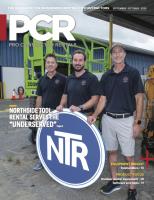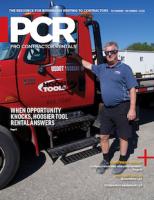Business Management -- Care and feeding of employees
Help employees become subject matter experts to increase the odds of them staying with your company.
by Sandra Mason
Personal and professional development is the key to a successful employee retention program. There is such a system, says Chris Czarnik, founder of Career Research Group, a company that helps organizations find great talent and engage employees.
The reason companies spend so much time recruiting new talent into their organizations, he explains, “is that they have forgotten if you have a hole in the bottom of the bucket, and you keep filling the bucket with water, you are losing talented people on the other side. That hole is when employees stop learning, they start leaving.”
Czarnik discussed this situation and offered solutions in his presentation, Employee Development is as Easy as SME, to AEM’s recent virtual Workforce Solutions Summit.
Consider your own experience
Think about the last time you left an organization. It probably had nothing to do with not being paid enough, or that initially you did not find the work interesting, says Czarnik. “Most likely, it had to do with you being a driven, talented individual with a desire to keep learning.
“The vast majority of people who leave an organization do so because they feel they are being taken advantage of or are not being noticed,” he says. “People’s number one desire in all the world is to be significant to someone or something.”
Challenges to overcome
Developing employees is challenging and complicated. It requires a considerable investment in money and time from managers, supervisors and the human resources department, Czarnik says. That is a reason companies do not do employee development well.
“Employers don’t know what they need or want their people to focus on developing; and employees are waiting for the organization to develop them,” he says.
Nobody talks to anybody and, at some point, the employee leaves, much to the surprise of management. “You will find when people are learning, they stay,” he says.
The new workforce
A major challenge facing companies is that the largest generation entering the workforce are millennials.
“The average millennial worker changes companies every 3.4 years. The No. one reason millennials give for leaving is a lack of learning, challenge and growth.”
Millennials were the first generation who had an electronic babysitter – video games – and are the first generation that does not know a world without Google.
Early on, millennials gained the ability to access information, find the materials they need and solve problems, says Czarnik. “They are in a constant state of learning. It is the way they grew up and we cannot expect them to stop doing this when they come to work.”
“In year one, employees become comfortable with the job,” says Czarnik. “In year two, they become comfortable with the company and why their work matters. In year three, they start looking for growth.”
To deal with year three, Czarnik recommends: “Put your managers and in a room and explain that if we want employees to stay, grow and feel engaged, instead of telling them what to do, explain why they are doing what they do.
“Managers and supervisors need to be creating conversation and relationships with people. They need to become more than just bosses. Have them explain every answer they give in terms of what and why.” he says.
Create an SME system
Czarnik recommends creating a subject matter expert (SME) system, where every employee is responsible for his or her own growth and can earn the right to become a SME.
Organizations have SMEs already, he says. These are people who know more than anyone else about one topic. It is someone who people go to when they have a question on a specific topic. However, these SMEs are unofficial and have no specific recognition. Create an army of SMEs from those employees in their third year with a company, says Czarnik. “We know they are looking for growth and have earned the right to grow because they treat people well, come up with answers, are involved in programs and are constantly looking for way to make the organization better. Make the honor of being an SME an aspirational thing for employees.”
Have managers and supervisors identify candidates. Then, leadership should identify 15 topics critical to the organization that would create a competitive advantage if it had an SME on those topics.
Develop an action plan
Once an organization has determined those employees who qualify to be an SME, offer them the opportunity to become one. “If they accept, it is particularly important that they get to choose from the SME topics list,” says Czarnik. “A topic cannot be assigned. You cannot tell a person to be interested or excited about a particular topic.”
SME candidates should be given two hours a week on company time to study their topic, using all the free material available on the internet, he says. Because they love their topic, they will probably spend their own time researching it.
This should continue for six months. Then, it is time to determine if the candidates have done the studying and have become an SME on their chosen topic.
Build a learning community
The SME should teach his or her topic at a very deep level to their direct manager or supervisor,” says Czarnik. “Over time, your direct managers or supervisors will become SMEs on topics your leadership has identified as the most critical to your organization.
“Instead of a manager or supervisor talking to an employee about due dates, start-up curves and uptime, they are having regular conversations about topics that are important and are learning from each other. This creates an educational community.”
After an employee has become a SME, he or she must be rewarded for his or her hard work, says Czarnik. “Money can be a part of it – perhaps a pay raise or bonus. The most important thing is to give them the title and honor of being an SME and announced it publicly.”
Once SMEs are in place, over the next year or two, a series of lunch-and-learns are held where an SME teaches his or her topic to the organization at some very high level of understanding. “Everyone starts using common language, begins thinking the same way and develops common ways of solving problems. Misunderstandings and arguments go away and the knowledge base increases across the topics most important to the operation.”
“An SME system creates an individualized development plan for every employee,” he says. It also creates a reservoir of talent and identifies future leaders.
“When you turn someone into a valued member that people come to daily for advice, guidance and feedback, when is that employee leaving? Companies tend to focus on money because it is the easiest knob to turn, but engaged, developing and active employees who are growing stay.”
For organizations that have implemented the SME system for the people they wanted to stay, the retention rate is around 96 percent, he says. “We utilize their skills well. We grow them.”
Want to learn more? Visit www.aem.org/workforce for more best practices, research, programs, and resources supporting workforce development for the industries AEM serves.
Sandra Mason is director of public relations at the Association of Equipment Manufacturers (AEM).
###
This article originally appeared in the November-December 2021 issue of Pro Contractor Rentals magazine. ©2021 Urbain Communications LLC. All rights reserved.










